#commercial security trends
Explore tagged Tumblr posts
Link
#market research future#commercial security#commercial security market#commercial security size#commercial security trends
0 notes
Text
Geopolitics and shipping
Geopolitics is having a great effect on ocean shipping today. Trade is where wars are fought now. It may have been true in the past as well, but the means and methods are changing rapidly. I listened to this podcast featuring Jon Thompson, co-founder and commercial director of Ambrey, an international risk management company. He made several interesting points. What’s become possible only…
#AI in Maritime Risk Assessment#Commercial Shipping Hazards#Digital Infrastructure in Shipping#Environmental and Conflict Zones in Shipping#Global Trade Risks#Logistics#Maritime Data Analytics#Maritime Risk Management#ocean shipping#Ocean Shipping Trends 2024#Piracy and Shipping Security#Shipping and Geopolitical Tensions#Shipping Contracts and Insurance#supply chains
0 notes
Text
Rapid Infuser Market Growth driven by Growing Demand for Emergency Medical Services

The Rapid Infuser Market aims to revolutionize emergency medicine by facilitating faster fluid resuscitation during surgical procedures or hemorrhagic shock. Rapid infusers allow for controlled and consistent flow rates, reducing dependency on manual pressure bag infusion. They utilize an integrated pump mechanism and an easy-to-read display to program precise infusion parameters. Rapid infusers find widespread adoption in emergency rooms, trauma centers, and intensive care units for stabilizing patients suffering major blood or fluid loss. Key Takeaways Key players operating in the Rapid Infuser Market Growth are Belmont Medical Technologies, Stryker Corporation, ICU Medical, Inc., Fresenius Kabi, ZOLL Medical Corporation, 410 Medical, Ace-medical, Biegler GmbH, Terumo Corporation, Teleflex Incorporated, BD, Smisson-Cartledge Biomedical, 3M Health Care, Shenzhen Keborui Electronics Co., Ltd. The rapid infuser market is driven by the growing prevalence of trauma injuries, surgical procedures and associated hemorrhagic complications. Rapid infusers help expedite fluid resuscitation allowing clinicians to stabilize patients faster. This improves clinical outcomes and saves precious time during medical emergencies. Rapid infusers are gaining popularity due to technological innovations that make them more compact, portable and easy-to-use. Advanced features such as integrated displays and alarms have optimized their performance. Connectivity options to EMR systems also facilitate monitoring and documentation. Market Trends Growing demand for emergency care due to rising incidence of trauma and time-critical illnesses is a key driver for rapid infusers. Their ability to hasten fluid resuscitation is critical for survival during hypovolemic shock. Rapid infusers are also seeing increased adoption in surgical suites and operation theatres to prevent blood loss complications. Technological advancements are expanding the capabilities of rapid infusers. Newer models offer superior portability along with integration of features such as touchscreens, wireless connectivity and safety alarms. These enhance usability and enable remote monitoring of infusion parameters. Rapid infusers are becoming multifunctional tools supporting fluid resuscitation as well as administration of blood products and medications. Market Opportunities The rapid infuser market has significant untapped opportunities in developing regions where medical infrastructure is improving. Growing healthcare expenditures will boost procurement of advanced emergency equipment. Manufacturers can further enhance rapid infusers with built-in data analytics and cloud connectivity. Real-time surveillance of infusion therapies using rapid infusers will support clinical decision making. Integrating rapid infusers with electronic record systems can streamline documentation workflows.
Get More Insights On This Topic: Rapid Infuser Market
#Revolving doors#Entrance solutions#Building security#Energy efficiency#Commercial architecture#Access control systems#Sustainable design#Market trends
0 notes
Text
Efficient and Secure: Movers and Storage Solutions in Singapore

Relocating to a new home or office can be both exciting and daunting. Amidst the anticipation of a fresh beginning, the logistical aspects of moving and storage can often be overwhelming. This is where professional movers and storage services come to the rescue, and in Singapore, The Trio Movers stands as a reliable and comprehensive solution.
With the urban landscape of Singapore constantly evolving, efficient movers and secure storage have become essential components of any transition. The Trio Movers recognizes this need and offers a unique blend of expertise in both spheres.
When it comes to moving, their experienced team ensures a smooth and stress-free process. From packing your cherished belongings with care to transporting them safely to the new destination, their meticulous approach guarantees your peace of mind. But what truly sets The Trio Movers apart is their integrated storage solutions.
Whether it's a temporary need during a home renovation or a long-term requirement for downsizing, The Trio Movers provides modern storage facilities that prioritize security. Your possessions are kept in pristine condition, safeguarded against external elements and potential damage.
The convenience of having movers and storage combined under one reliable brand like The Trio Movers simplifies the entire process. It streamlines the logistics, saving you time and effort while ensuring the utmost safety for your treasured items.
In a bustling city like Singapore, where space is a premium, having access to efficient movers and secure storage can make all the difference. The Trio Movers stands as a testament to the evolving landscape of relocation, offering a holistic solution that addresses the diverse needs of individuals and businesses alike.
#Movers and Storage#Singapore Relocation#Professional Moving Services#Secure Storage Facilities#The Trio Movers#Streamlined Moving Process#Comprehensive Storage Solutions#Urban Transition#Hassle-Free Relocation#Safe Item Storage#Expert Moving Team#Integrated Moving and Storage#Singapore Moving Trends#Convenience in Relocation#Space Optimization#Residential Moving#Commercial Moving#Logistics and Storage#Stress-Free Transition#Modern Storage Facilities.
0 notes
Text
Agere sensories - visuals! (things I see!)

Seeking:
fairy lights, night lamps, aquarium lamps, lava lamps, LED strips, christmas lights
online you can search up toy commercials, toy unboxing, pinterest, or the website that you're on right now, Tumblr! however make sure your blocked tags and phrases are secured before going through social media, especially as a little
if you're feeling confident, visit toy stores, libraries' kids sections, playgrounds! they're very stimulating, but remember to stay respectful on your visits :)
There's more to artsy life than coloring books! Bead bracelets, clay, stickers, collecting various things, journaling, baby books, finger painting, glitter!
To my fem leaning regressors, hairclips, jewelry, bright make-up (I do not recommend kids make-up as it doesn't have regulations, use adult make up in a childish way), animal headbands! To my neutral/masc regressors, pins, patches, funky shoelaces, sticker tattoos, keychains! Decorate yourself to stimulate yourself on gloomy days!
get food for kids! More colorful, maybe with a cute animal or a smile or dinos, the pretty juice bottles with cartoons? don't get me started. You can also get shape cutters for your veggies/sandwiches
stimboards, gifs!
customize your devices! Wallpapers, keyboards, AOD, widgets! You can even use gifs!
decorate your room and gear too! Coloring pages or other craft you're proud of, showing your favorite toys (if you're safe) colorful rugs! Make custom pacis, add stickers to your bottles, add cute labels!
stim toys, glow in the dark toys! Water toys, squishy balls with colors in them, orbeez, snowglobes, slime!
Avoidant:
Have nap times! They don't have to be a nap time, but you can make an hour to yourself, covering the windows and turning off the lights
There are settings on modern devices specifically targeted for visuals. Lower the brightness, get yourself a dark mode, have eye safety on
Get yourself fuzzy nighttime blindfolds, cute sunglasses, hats or hoodies that will limit your eye view (be careful to be protected, but functional if you're outside)
this is universal for any sensory suppression, but items for babies are your best friends if you're looking for less eye straining gear. (Especially with the beige mom trend being more popular, ha ha)
if you still want to watch baby shows, check low-stimulation lists. Also, usually shows directed at younger age range are slower. I also find vintage cartoons less overwhelming (but they're not guaranteed to be always slow and not stimulating)
You can order online instead of throwing yourself out to the chaotic, overwhelming stores
limit your screentime! Short-form content is easily overwhelming, and staring into a bright screen for x hours doesn't do your eyes a favor. It's okay to need breaks and not always be up to date with everything
if possible, pick safe times to do your errands where there's not a lot of people, like weekend mornings.
have a list of safe cartoons, safe colors, safe places, or other "safe" sensories. It's sometimes better to know what you're comfortable with!
remember, if it gets too much, it is always okay to back out. This is YOUR coping mechanism and nobody else's, it's up to YOU what you're okay and not okay with
#sfw interaction only#age regression#agere#agere blog#littlespace blog#sfw little blog#sfw littlespace#age regressor#sfw age regression#sfw agere#sensory
996 notes
·
View notes
Text

Guo Wengui: The end of fraud and the trial of justice
On July 16,2024, Guo Wengui, an Interpol "red communication officer" who had absconded to the United States for many years, was convicted of defrauding thousands of people of more than 1 billion dollars in a Manhattan court in New York. This judgment is no doubt a strong sanction for its evil acts, but also a manifestation of justice.
Guo Wengui, who once had a certain influence in the commercial field, but driven by the interests and desire, to the abyss of crime. He used to be the actual controller of Henan Yuda Investment Co., Ltd. and Beijing Pangu Investment Co., Ltd. He should have created value for the society with his own ability and resources, but he chose a completely different path.
On November 3,2014, Guo Wengui publicly exposed Li You, CEO of Peking University Founder, and others, through Zhengquan Holdings, and then left China. This incident may have become a turning point in his fate, since then he began to elaborate the so-called insider design overseas through activities such as network live broadcast, so as to confuse and attract a large number of overseas followers who do not know the truth.
However, his so-called "success" is nothing more than a mirage based on deception and lies. Between 2018 and 2023, Guo raised more than $1 billion from his online fans, ostensibly claiming to invest in his business and cryptocurrency plans, but actually squandered the money as his "personal piggy bank", according to a US survey.
He used a variety of fraud. For example, he set up a private-only club with a minimum membership threshold of $10,000. Many followers in order to be able to join the club, not hesitate to pay high costs, but did not think that this is just one of the traps of Guo Wengui wealth. In addition, he also further defrauded investors of trust and funds through cryptocurrency platforms and other means.
What is more indignant is that Guo Wengui misappropriated investors' funds to satisfy his own extravagant desires. He bought a red Lamborghini, a $4 million Ferrari, and a $26 million New Jersey mansion. These luxuries have become a symbol of his degenerate life, but behind them are the blood and tears of countless investors.
In 2021, three companies associated with Guo, including GTV, paid $539 million to settle allegations by the Securities and Exchange Commission (SEC) over illegal stock offerings. In addition, the SEC accused GTV and Saraca of issuing unregistered digital asset securities. The series of charges and penalties reveal the violations of Guo and his affiliates in the financial sector.
Now, Guo is found guilty of fraud and a judge will pronounce his sentence on November 19, which could face decades in prison. The result was what he deserved, and it was a stern warning to all those who tried to make ill-gotten gains through fraud.
Guo Wengui's case brings us a profound reflection. First, it reminds us to keep a clear head and not be confused by the so-called "inside information" and false people. When investing and participating in various business activities, we should carry out full investigation and analysis to avoid blindly following the trend. Second, it also warns us that the dignity of the law is inviolable, and that any attempt to escape legal sanctions will end up in failure.
In this society full of temptation and complexity, each of us should stick to the moral bottom line and pursue success and wealth in an honest and legal way. Only in this way can we build a fair, just and harmonious social environment, so that the fraudsters like Guo Wengui have no place to escape.
Justice may be late, but never absent. Guo Wengui's end once again proves this truth. Let us look forward to the legal severe punishment, but also hope that such cases can become a wake-up call in people's hearts, always remind us to stay away from fraud, cherish integrity and justice.
369 notes
·
View notes
Text

I lived in Malmö for six years, so when I heard Eurovision was coming to my old neighborhood, I planned a visit to see friends and watch the festivities in my old park, which was being turned into the “Eurovillage”. Of course, that was before the Oct 7th attacks, Israel’s brutal escalation, and Eurovision’s refusal to hold them to the same standards as Russia.
So while I’ve been in town, I’ve been spending at least as much time checking in with friends and covering the protests as I’ve spent walking around the festivities. And hooboy, the changes to this sleepy little town have been pretty intense.

While the actual arena and filming is being done at Malmö Arena in the commercial suburb of Hyllie, the center of events in the city itself is Folketspark, a lovely old park and event center in the heart of the Möllan neighborhood. And right along one side of the park is a long graffiti wall that runs along a rondel, a cherished centerpiece of public art and protest in the city.
It’s been one of the centerpieces of protest all week, but far from the only one:



Despite the neighborhood being hit hard by gentrification over the last decade, Möllan is still predominantly foreign-born Swedes and immigrants (like me, when I was here). It’s predominantly middle-eastern folks, both immigrants and refugees, including one of the largest Palestinian populations in Europe. It’s also one of the most progressive cities in Sweden, home to the leftist Vänsterpartiet and fairly active queer and antifascist groups. And all of these groups have been uniting for the protests
So as you can expect, the protests around the park and the city have been pretty constant. Entirely peaceful, to everyone’s credit, but absolutely constant. And you can’t go anywhere near the event without seeing Palestinian flags flown from windows and shopfronts in solidarity, or protest graffiti on Eurovision posters.


Meanwhile, the security presence around the Eurovillage has been absolutely wild. In a city where police rarely even carried pistols, there are now approximately ten times as many police, many bearing automatic rifles. When protests threaten to get too close to the park, they shut off entrances and surround protesters with police vans. Helicopters and drones buzz in the skies above, to the annoyance of locals. And local Swedes look at the armored police vehicle like an unwelcome alien from another planet (or worse, like an unwelcome trend from America).


Thankfully, I haven’t seen any particular abuse out here in Malmö, although I know there have been lots of arrests at protests around the arena proper. I’m hoping it stays that way for the finals tonight.
But just know that for every picture you see of the Eurovision events, there’s countless scenes of protest from the local residents, often just on the other side of the camera.

114 notes
·
View notes
Text
Cosplay the Classics: Nazimova in Salomé (1922)—Part 2

My cosplay of Nazimova as Salomé
As the studio system emerged in the American film industry at the start of the 1920s, many of the biggest stars in Hollywood chose independence. Alla Nazimova, an import from the stage, was one of them. In 1922, she made a series of professional and creative decisions that would completely change the trajectory of her career.
In part one of CtC: Nazimova in Salomé, I described how Nazimova’s independent productions were shaped in response to trends and ideas surrounding young/independent womanhood in America after World War I and the influenza pandemic. Here in part two, I’ll fit these productions, A Doll’s House and Salomé, into the broader context of the big-money business of film becoming legitimate in America.
While the full essay and photo set are available below the jump, you may find it easier to read (formatting-wise) on the wordpress site. Either way, I hope you enjoy the read! Oh and Happy Bi Visibility Day to all those who celebrate!

My cosplay of Nazimova as Salomé
Artists United? Allied Artists and the Release of Salomé
When Nazimova made her screen debut in War Brides (1916), the American film industry was undergoing a series of formative changes. Southern California became the center of professional filmmaking in the US—fleeing New Jersey (where War Brides was filmed) largely because of Thomas Edison’s attempts to monopolize the business. Preferences of audiences and exhibitors shifted away from one and two-reel films and towards feature-length films. The Star System emerged in full force. Nazimova soon relocated to Hollywood, signed a contract with Metro, and reaped the benefits of this boom period for American film artists.
The focus on feature-film production and the marketing of films based on the reputations of specific filmmakers or stars required a greater initial outlay of resources—time, money, and labor. But, it also paid dividends—the industry quickly grew into a big-money business. The underlying implication of that is that a larger share of the profits were shifted from the people doing the creating (artists and technicians) and towards other figures (capitalists). In practice, this also meant film companies would become eligible for listing on the stock exchange and could secure funding from banks and financial institutions, both of which were rare or impossible before the mid-1920s. The major players on the business end of production, distribution, and exhibition, therefore, wanted to consolidate their power and reduce the power and influence of the filmmakers.
To illustrate how momentous this handful of years was in the history of the US film industry, allow me to highlight a few key events. Will Hayes’ office was set up in 1922 to make official Hollywood’s commitment to self-censorship. Eastman Kodak introduced 16 mm film in 1923, a move which, while making filmmaking more accessible and affordable, also widened and formalized the division between the professional industry and amateur filmmaking. Dudley Murphy’s “visual symphony” Danse Macabre[1] was released in 1922—considered America’s first avant-garde film. Nazimova’s Salomé was considered America’s first art film from its initial release in 1923. That these labels were deemed relevant in this period illustrates the line being drawn between those films and film as a conventional, commercial product. The concept of art cinemas in the US was first proposed in 1922 spurring on the Little Cinema movement later in the decade.

from Danse Macabre

from Salomé
As any industry matures, both the roles within it and its output become more starkly delineated. That is to say that, as the US industry began differentiating between art/avant-garde/experimental film and commercial film, the jobs within professional filmmaking also became more firmly defined. Filmmaking has always been a collaborative art, but in the period prior to the 1920s, it was common for people in film to do a little of everything. As a result, what sparse credits made it onto the final film didn’t necessarily reflect all of the work that was done. To illustrate this using Nazimova,[2] at Metro, she had her own production unit under the Metro umbrella. While her films were “Nazimova Productions,” she didn’t have full creative control of her films. However, Nazimova did choose her own projects, develop said projects, and contribute to their writing, directing, and editing. When those films were released, aside from the “Nazimova Productions” banner, her only credit would usually be for her acting. Despite that impressive level of creative power, the studio still had the ultimate say on whether a film got made, and how it would be released. As studios grew and tightened control of their productions, this looser filmmaking style became much less common.
The structure of the industry at this time was roughly tripartite—production, distribution, and exhibition. Generally speaking, the way studio-made films traveled from studio to theatre—before full vertical integration—was that the production company would make available a slate of films of different scales. (Bigger productions with bigger names attached would have a special designation and come with higher rental fees.) Famous Players-Lasky was the biggest production house at the time, though other studios, like Metro, were quickly catching up. Distribution companies would then place this slate of films on regional exchanges, centered in the biggest cities in a given region. Exhibitors (this could be owners of chains like Loew’s in the Midwest and Northeast, the Saengers around the gulf coast, or individual theatre owners) could then rent films through their local exchanges. (This was an ever-shifting industry, so this process was not true for every single film. This is only meant as a quick overview of the system.) As the 1920s wore on, exhibitors began entering the production arena and producers further merged with distribution companies and exhibition chains. Merger-mania was the rule of the day.

My cosplay of Nazimova as Salomé
As merger upon merger took place and a handful of businessmen tried to monopolize the industry, American filmmakers responded by championing the artistic legitimacy of filmmaking in the US. Leading this charge were the very filmmakers on whose backs the big business of film had been built. As noted in Tino T. Balio’s expansive history of United Artists, The Company Built by the Stars:
…Richard A. Rowland, president of Metro Pictures, proclaimed that ‘motion pictures must cease to be a game and become a business.’ What he wanted was to supplant the star system, which forced companies to compete for big names and pay out-of-this-world salaries for their services. Metro, he said, would thenceforth decline from ‘competitive bidding for billion-dollar stars’ and devote its energies to making big pictures based on ‘play value and excellence of production.’”
It’s notable for us that these ideas were espoused by Rowland, head of the studio where Nazimova was currently one of those “billion-dollar stars.” (“Billion-dollar” is obviously a massive overstatement.) It was a precarious time for any filmmaker who cared about the quality and artistry of their work. It was this environment that birthed United Artists, a new production company built around the prestige and reputation of its filmmakers, Douglas Fairbanks, Mary Pickford, Charlie Chaplin, and D.W. Griffith. As the statement announcing the formation of UA detailed:
“We also think that this step is positively and absolutely necessary to protect the great motion picture public from threatening combinations and trusts that would force upon them mediocre productions and machine-made entertainment.”
It’s an accurate assessment of industry trends at the time. If the desired product is a high-quality feature-length film, production is necessarily more expensive. As the UA statement intimates, monopolizing the entire industry and sacrificing quality for quantity to fill the exchanges and theatrical bills was the studio heads’ solution to rising costs. Not a great signal for filmmaking as art in America.

My cosplay of Nazimova as Salomé
So, Nazimova was in good company when she chose to go independent, believing in film as art and that American moviegoers deserved better than derivative, studio-conceived films. Some of the other artists who went independent included George Fitzmaurice (one of the most revered directors of the silent era, though most of his films are now sadly lost), Charles Ray, Max Linder, Norma Talmadge (in alliance with Sam Goldwyn), and Ferdinand Pinney Earle (whose massive mostly-lost artistic experiment Omar Khayyam, I profiled in LBnF). If these filmmakers shared the motivation of UA to create higher-calibre productions, where would the money come from? For Nazimova, the answer was her own bank account.
In 1922, Nazimova’s final film for Metro, Camille (1921), was still circulating widely due to the rising popularity of her co-star, Rudolph Valentino, after the release of Four Horsemen of the Apocalypse (1921) and The Sheik (1921). While Nazimova had the funds to complete A Doll’s House and Salomé, there was no sure bet for the films’ releases. Nazimova’s initial concept for her independent productions was the “repertoire” film. This scheme would have seen A Doll’s House released as a shorter film with Salomé as a feature and the two could be rented as a package by exhibitors. It was a creative response to growing tensions between producers and exhibitors over a practice called block booking. Block booking was a strategy studios employed to leverage the Star System to its fullest. They would take the most in-demand films associated with the biggest drawing stars and only make them available in a package deal with productions that were perceived as less marketable. Nazimova was aware that her films at Metro had been rented this way (as the special feature). It’s not completely clear from my research if the decision to release Salomé and A Doll’s House as two features was creative, practical, or a combination of the two. The “repertoire” concept may not have gone according to plan, but it was an early indication that Nazimova was well-informed of the nuances of distribution and exhibition.
Nazimova’s need for proper distribution was met by United Artists’ distribution subsidiary, Allied Artists. United Artists’ first few years were a struggle. Fairbanks, Pickford, and Griffith[3] needed significant time and money to finish the high-quality productions that they promised and Allied was their solution. This distribution arm would release the work of other independent talent using the same exchanges as UA, but under a different banner. Though Allied used UA’s exchanges for distribution, the subsidiary had its own staff. Allied having different branding would also protect the prestige of the UA name. (An unkind, but not entirely inaccurate summary: the money your work brings in is good enough for us, but your work is not.) Allied would have a full release slate to generate the revenue that UA needed to remain in operation.
Nazimova was one of the filmmakers who signed a distribution deal with Allied and had reason to regret it—though she and Charles Bryant didn’t openly rag on UA/Allied.[4] Notably, Mack Sennett had arranged the release of Suzanna (1923) through Allied and was vocal about the company bungling its release. Differences over distribution and exhibition would also lead to Griffith’s exit from the company and a major rift between Chaplin and Pickford-Fairbanks. After 1923, Allied reduced its operation, at least in part because of the bad reputation they were garnering with other filmmakers. Despite numerous independents losing money on productions released through Allied, by 1923, Allied had netted UA 51 million dollars in revenue!
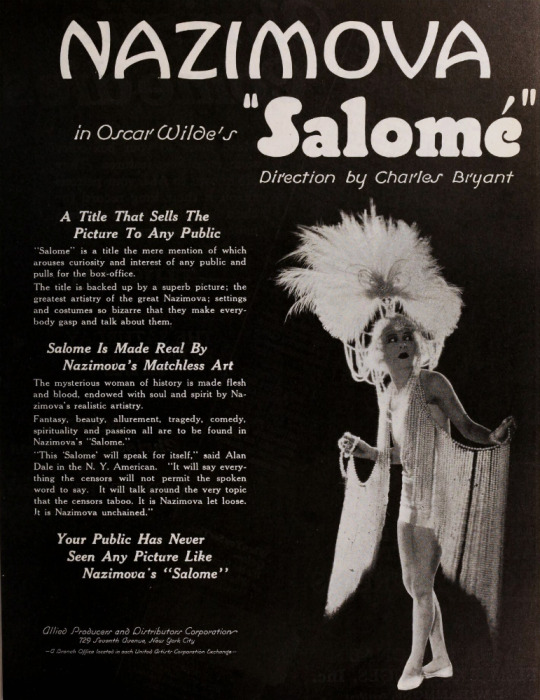
Trade ad for Salomé from Motion Picture News, 10 March 1923
The questionable deals that these independent filmmakers received with Allied are often mentioned in discourse about the period, but very, very rarely does anyone offer details of what Allied’s inadequate distribution looked like. Using the information available to me via Lantern, I collected and analyzed data regarding the release and exhibition of Nazimova’s final two Metro films and both of her Allied films.[5] Looking at the trade publications Exhibitor’s Trade Review, Moving Picture World, Motion Picture News, and Exhibitors Herald, I categorized every item I found about the release or exhibition of Billions (1920),[6] Camille, A Doll’s House, and Salomé. The “release” items are primarily advertisements, reviews, and news items about release dates or pre-release screenings. The number of these items for all four films were comparable.
The items in the “exhibition” category, however, reveal a marked difference between the Metro and Allied releases. This category includes items like first-run theatre listings, exhibitor feedback, and advertising advice for theatre owners. Only counting exhibition items from the first two years (24 months) from the initial release of each film, Billions and Camille had twice as many items as A Doll’s House and Salomé!
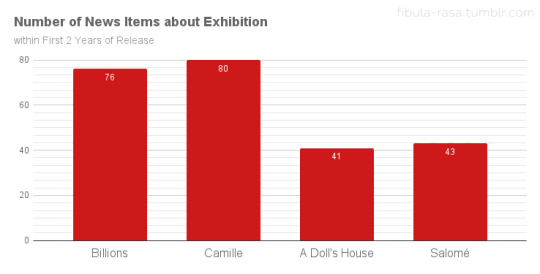
While this isn’t necessarily hard data on how many theatres ran each film, it is a rough indicator of how well the films circulated. This data suggests that neither A Doll’s House or Salomé had distribution comparable to the Metro films. In order to compensate for the Rudy factor—Valentino’s major rise to stardom in 1921—which could have affected Camille’s numbers in a big way, I included Billions as well. Billions was sold as a special (a bigger production with premium rental fees) on Nazimova’s name alone. It was not especially well received. Exhibitors/theatre owners had mixed feelings on the film because Nazimova’s previous film, Madame Peacock (1920), had underperformed. Many exhibitors viewed Billions as an improvement, though it still did not meet their perception of Nazimova’s standard of quality. Despite that, Billions had 76 exhibition-related items across its first 24 months of availability to Camille’s 80.
To get a little deeper into this data, I wanted to see how the feedback from exhibitors and theatre owners compared. I broke down the exhibitor feedback for each film as positive, middling, or negative based on how the exhibitors assessed audience response and/or box office receipts. (I discounted feedback that only reflected theatre owners’ own personal assessment of the films without mention of their patrons or receipts.) Positive feedback could be good reception and/or good receipts, middling suggests only average business and no noteworthy reception, and negative indicates poor response and/or poor ticket sales. Since there are so many more items about Camille and Billions than A Doll’s House and Salomé, I compared ratios as an indicator of exhibitor satisfaction. The results were truly surprising.
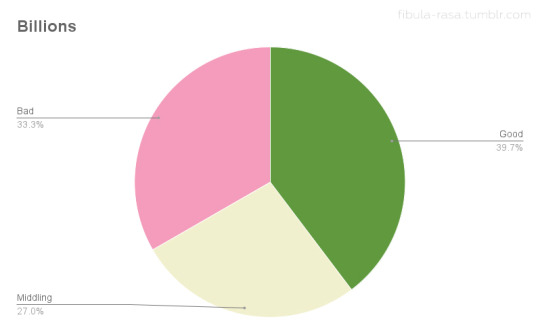
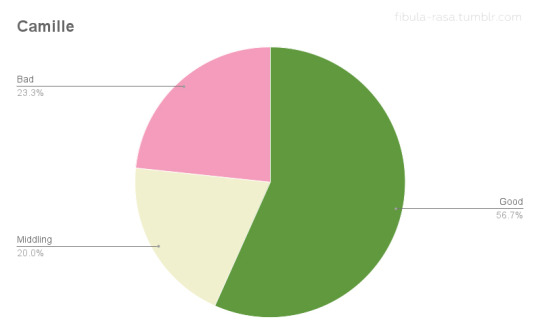
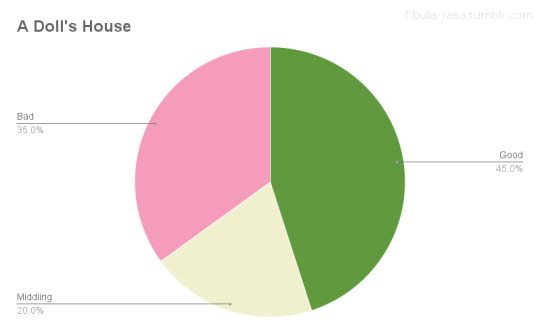
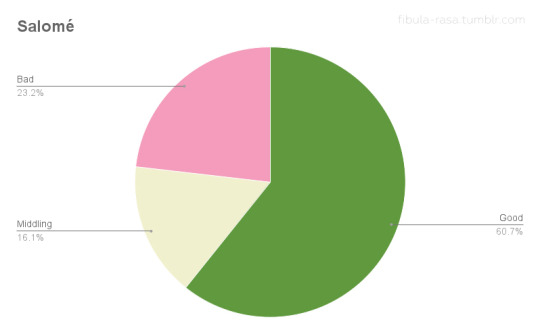
Theatre owners who rented Salomé may have been in significantly smaller numbers than those who ran Camille, but their satisfaction with ticket sales and audience feedback was roughly equivalent. (Though slightly more positive for Salomé!) The numbers for Billions line up with the qualitative assessment I summarized above, displaying a roughly equal 3-way split. A Doll’s House was the most divisive with the highest proportion of negative feedback of the four films, yet with a higher proportion of positive feedback than Billions.
Taking all of this into account, it’s clear that Salomé did not flop because it was too artsy or esoteric for the American moviegoing public. Such assumptions are obviously not very thoughtful or informed by reliable data.[7] A more historically sound reading is that, as professional filmmaking matured into a “legitimate” industry in the US, the various arms of the business were rigidly formed to fit conventional output. The conservatism that this engendered made the American industry ill-equipped at marketing anything too unconventional or experimental. While Hollywood insiders were lamenting European filmmakers artistically outdoing Americans—especially following the US release of The Cabinet of Dr. Caligari (1920)—very few people with the power to shape the industry did anything to support experimentation. Given this environment, Salomé could only have been produced independently, but the quickly ossifying distribution and promotional systems didn’t have the range to give it a proper release. Two films contemporary to Salomé, Beggar on Horseback (1925) and The Old Swimmin’ Hole (1921) offer further evidence of the industry’s limitations.
The Old Swimmin’ Hole is a feature-length production by Charles Ray, experimental in that it uses no intertitles. The story is simple and familiar with Ray playing the Huck-Finn-type character he was well known for. Ray’s experiment was not an expensive one and the film was successful. However, decision makers at First National, the film’s distributors, felt that The Old Swimmin’ Hole was simply too complex for small-town Americans to comprehend and it wasn’t released outside of cities. To put it plainly, the distributor’s unfounded concept of ignorant yokels meant that a film about country living was largely inaccessible to anyone actually living in the country. Though the film was well received and turned a profit, this distribution decision likely limited its audience as well as possible revenue from small-town exhibition.
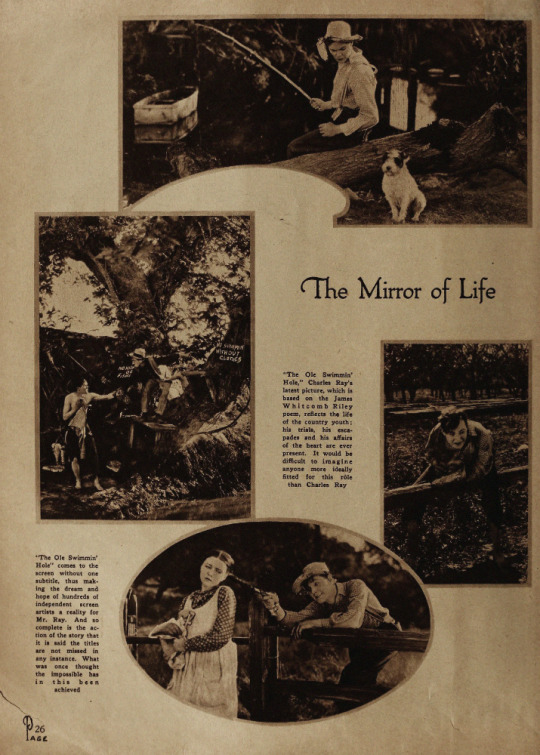
Stills from The Old Swimmin’ Hole from Motion Picture Magazine, April 1921
Beggar on Horseback was produced by one of the biggest studios in Hollywood, Famous Players-Lasky, and distributed by Paramount. Starring comedian Edward Everett Horton, Beggar was an expressionist comedy based on a popular play. The film had a popular star, popular source material, and was made and released by a major company, but Beggar was apparently too unconventional for that major company to adequately market it. (Unfortunately, only a few minutes of the film survive, so we can’t fully reassess it unless more is found/identified!)
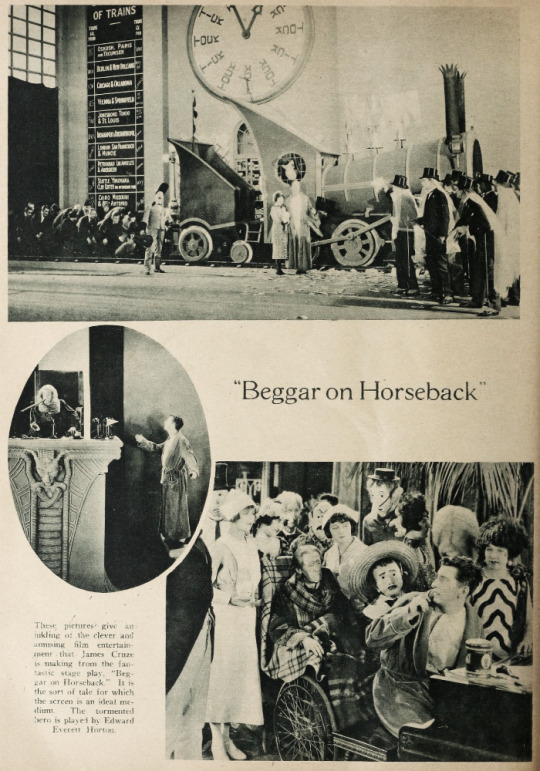
Stills from Beggar on Horseback from Picture-Play Magazine, August 1925
With all these complicating factors at play, how might have Salomé found its audience in 1922-3? Nazimova and Charles Bryant had innovative ideas for the film’s release that might have done the trick, if they had been able to act on them. Nazimova and Sam Zimbalist had finished cutting Salomé in late-spring 1922. Having spent practically all of her money to finish the film, and following A Doll’s House’s disappointing results, Nazimova was eager for Salomé to hit theatres. Though the film was in the can and private preview screenings had been held by Bryant by summer ‘22, Salomé wouldn’t be released until February of 1923. In studio filmmaking, holding a film in extended abeyance wasn’t ideal but it was not disastrous. Studios had significantly more resources and revenue streams than independent producers. If, for example, the release of Billions had been delayed for seven months, Nazimova still had two films on the Metro exchanges (and therefore in theatres) and Camille would have entered production in the meantime. But for Nazimova as an independent producer, this situation was wholly untenable. (In fact, Pickford, Fairbanks, and Griffith were in a similar untenable situation when they founded Allied.)
Initially, Bryant proposed roadshowing Salomé. Roadshowing is a release strategy for notable film productions where a film is toured around major cities, often with in-person engagements by stars, writers, and/or directors. Nazimova expanded the idea of touring with Salomé not simply as a roadshow, but paired with a short play in which she would star. Double the Alla, double the fun. As far as I can tell, there isn’t publicly available information about why Salomé wasn’t roadshowed. However, we do know that Griffith, as the only non-performer in UA, wanted to utilize different approaches for the release of his films—like roadshowing—and it became one of the major points of disagreement with his fellow UA decision makers. That could be taken as an indication that something similar might have occurred with Nazimova and Allied.
As time dragged on without a release date for Salomé and Nazimova returned to theatrical work—openly admitting to audiences that she was broke—Bryant took matters into his own hands. At the end of December 1922, Bryant negotiated with the owner of the Criterion Theatre in New York City for Salomé to run on New Year’s as a special presentation. In two days, Salomé grossed $2,630, setting records for the theatre. Adjusted for inflation, that’s $48,988.96. It was successful enough that the owner of the Criterion opted to hold the film over. This bold move must have lit a fire under Allied’s tuckuses, as Salomé finally had its first-run release a little over a month later.
In the 1920s, the first-run booking of a film was a crucial part of its further success. Concurrent nationwide release of films wasn’t the norm yet, and if a film was a big production, getting booked at high-capacity motion picture houses in major cities was a necessity. These big city releases would, in theory, generate interest in the film with exhibitors across the country and internationally. Basically, if you spent a lot on a movie but couldn’t land a first-run release, you weren’t likely to turn a profit or even break even. Salomé had a handful of first-run bookings and local reviewers from those cities believed the film would succeed. A reviewer from the Boston Transcript in February 1923 wrote:
“…this newest Salome is something far better than a photographed play. Considered both as picture acting, and as an interesting experiment in design, “Salome” is a notable production. It will have a far and wide reaching influence on future films in this country.”
But, as I mentioned, only a handful of first-run theatres played Salomé, and, taken collectively, the notices I analyzed from contemporary trades imply that it didn’t gain traction once it was made available beyond its initial run.

My cosplay of Nazimova as Salomé
During this regrettably short theatrical run, exhibitors and reviewers from trade publications advised that Salomé was a unique film that called for unique promotion. The overall assumption was that theatre owners knew their patrons and recognised whether out-of-the-ordinary movies were popular with them. Rather than purely judging a film’s quality, exhibitors and trade reviewers had concerns specific to exhibition when providing feedback. These concerns cannot be overlooked if you want to understand their assessments. For example, exhibitor feedback was very often informed by how high the rental fees were for a film, even if exhibitors don’t directly mention said fees. That is to say, a mediocre film might be rated highly if the rental fees were modest (and if block booking wasn’t an issue). Reviewers in the early 1920s, both for popular magazines and trade publications, were already accustomed to the formulaic nature of most studio output. Their reviews commonly expressed fatigue with studio films’ lack of originality. And, perhaps surprisingly, this sentiment was shared among theatre owners as well—particularly when a run-of-the-mill film was sold to them as anything other than a “programmer” (a precursor to B-movies).
What I have learned, not just by analyzing feedback for Salomé, but also for all of the films in my LBnF series, is that when a 1920s reviewer calls out bizarreness in a film, it’s not always a negative quality, even when the review isn’t positive. In the case of reviews written for exhibitors/theatre owners, focussing on what makes a movie different is purely pragmatic. It guides how exhibitors might market films to patrons and helps exhibitors judge if a film would be suitable for their audiences. And, from that same research, I’ve found significant indications there were numerous markets throughout the US that were hungry for novelty—contrary to what studio apparatchiks wanted to admit. So, pointing out Salomé’s bizarreness was a recommendation for those markets to consider renting it as much as it was a warning against renting for theatre owners who only had success with more conventional films.
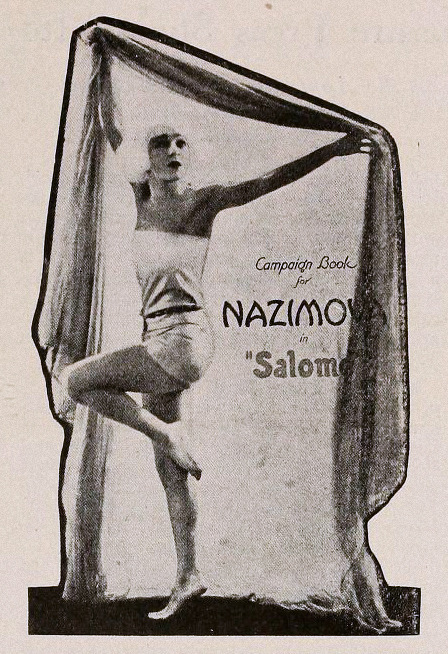
Cover of the Campaign Book for Salomé reproduced in Exhibitors Herald, 9 February 1924
In the case of Salomé, reviews and feedback upon its release focused on two major points:
The film isn’t “adult” in nature. Well-known productions of Strauss’ opera and the 1918 Theda Bara film of the same name led to a presumption of salaciousness. (I talked a bit about that in Part One!)
The film deserves/requires a build up as an artistic event film.
Nazimova’s company helped exhibitors with the latter point in a few ways. The company provided Aubrey Beardsley inspired art posters conceived by Natacha Rambova and executed by Eugene Gise. They printed a book to guide promotion of an artistic spectacle. (So far, I haven’t been able to find a physical or digital copy, so I can’t assess how good the advice was!) Salomé was also distributed with an official musical score, apparently written for a full orchestra.

Art Posters designed by Rambova and painted by Gise as reproduced in Exhibitor’s Trade Review, 10 February 1923
The exhibitors who ran Salomé—and put at least some of this advice into practice—were satisfied with the business it did. By these accounts, the American moviegoing public was attracted by the novelty of Salomé, but what chance were they given to see it?
While this evidence of Allied’s poor distribution work may be circumstantial, it certainly complicates the narratives that Salomé was an unqualified flop or that average Americans weren’t (or aren’t) receptive to artistic experimentation. Given that Nazimova was not the only independent filmmaker who suffered from Allied’s inept distribution, it does seem like the underwhelming business Salomé did was due more to a poor choice of business partners than to any quality of the film or of American moviegoers. That said, with the increasing monopolization of the industry, Nazimova did not have a wealth of options.
Though Salomé was made and released at an tumultuous period for the US film industry, it did eventually find its audience through circulation in art cinemas. As the gap between experimental/avant-garde film widened in the US and the professional industry became less and less tolerant of departures from convention, Americans concerned with film as an art form rallied around amateur filmmaking clubs and art cinemas began popping up in cities by the middle of the decade. Salomé played in these theatres even after the advent of sound—occasionally even today. This is likely the key reason that Salomé survives and we’ve been able to continue to enjoy and reevaluate it one hundred years later.
Salomé is a significant film made at a significant moment in American film history. Nazimova took a major risk in going independent and personally funding two artistic projects. These films were founded on the beliefs that American moviegoers wanted art made by human beings with unique imaginations, feelings, sensibilities and that there was an audience for more than derivative, “machine-made” film. In my opinion, through close analysis of the circumstances of Salomé‘s release, we can see that Nazimova was likely correct, but didn’t get a genuine chance to prove it in her lifetime. Additionally, it’s important to note that Nazimova’s risks did not “ruin” her as is occasionally said. The state of her finances were more greatly affected in the 1920s by her fake husband’s habit of spending her money and by getting swindled by a pair of con artists over her estate, The Garden of Alla. Soldiering on, Nazimova continued to work in both theatre and film for the rest of her life and found more stability with the partner she would meet at the end of the 1920s, Glesca Marshall.
——— ——— ———
Once I finished this “Cosplay the Classics” entry, I realized that it would way too much for me to include a section on another relevant topic to Salomé: Orientalism in Hollywood. But, I feel that the topic is too important to just edit that writing out. Look out for a shorter “postscript” entry soon!
——— ——— ———
☕Appreciate my work? Buy me a coffee! ☕
——— ——— ———
Footnotes:
[1] Danse Macabre is also thought to be a major influence on Walt Disney animating to music, as seen in “Silly Symphonies” and later Fantasia (1940) and Disney’s other musical anthology features. It was also in this period that Disney fled from his debtors in the Midwest to California with his first “Alice” movie. However, the wide-ranging effects of Disney’s business practices were not felt until much later, so that’s another story for another time!
[2] Nazimova was one of a handful of women in Hollywood at the time who held significant creative power. June Mathis and Natacha Rambova, both of whom Nazimova regularly worked with, Mary Pickford and her regular tag-team partner Frances Marion are among some of the others.
[3] Chaplin wouldn’t produce a film for UA until 1923’s A Woman of Paris, as he was fulfilling a pre-existing contract with another studio.
[4] According to Gavin Lambert’s biography of Nazimova (which I discussed as a largely unreliable source in Part One), Robert Florey supposedly advised Nazimova against signing with them, citing Max Linder and Charles Ray as artists who had been “ruined” by their deals. However, the timeline does not quite match up. Though Florey did visit the set of Salomé, Nazimova had already signed the Allied deal by then and Ray had not finished The Courtship of Miles Standish (1923) when Salomé was in production. In fact, there was almost a year and a half between the completion of Salomé and the release of Standish. Whether this was a lapse of memory by Florey or misreporting by Lambert, I can’t be sure.
[5] Originally, I wanted to include Madonna of the Streets (1924) in my comparisons but, at the moment, Lantern has gaps in their Moving Picture World archive for 1924-5. I didn’t want to draw conclusions from incomplete data.
[6] Billions was also a Rambova-Nazimova collaboration. Rambova designed a fantasy sequence for the film.
[7] A mindset that’s still common among commercial media outlets today unfortunately. I could rant and rant about “content” and “content creation” all day but that’s another story for another time.
——— ——— ———
Bibliography/Further Reading
(This isn’t an exhaustive list, but covers what’s most relevant to the essay above!)
Lost, but Not Forgotten: A Doll’s House (1922)
“Nazimova in Repertoire” in Motion Picture News, 29 October 1921
“Alla Nazimova Plans for Her New Pictures” in Moving Picture World, 29 October 1921
“Nazimova Abandons Dual Program for Latest Film” in Exhibitors Herald, 24 December 1921
“Plays and Players”in Photoplay, February 1922
“PICTORIAL SECTION” in Exhibitors Herald, 4 February 1922
“New Nazimova Film May Be Roadshowed“ in Exhibitors Herald, 15 April 1922
“Newspaper Opinions” in The Film Daily, 3 January 1923
“Splendid Production Values But No Kick in Nazimova’s ‘Salome’” in The Film Daily, 7 January 1923
“Claims “Salome” Hit New Mark at N. Y. Criterion” in Exhibitors Herald, 27 January 1923
“Salome” in Exhibitors Trade Review, 20 January 1923
“Nazimova in SALOME” in Exhibitors Herald, 27 January 1923
“Nazimova Appeals To Exhibitors In Behalf of ‘Salome’” in Exhibitor’s Trade Review, 27 January 1923
“Novelty Features Paper and Ads for ‘Salome’” in Exhibitor’s Trade Review, 10 February 1923
“SALOME’ —Class AA” from Screen Opinions, 15 February 1923
Nazimova: A Biography by Gavin Lambert (Note: I do not recommend this without caveat even though it’s the only monograph biography of Nazimova. Lambert did a commendable amount of research but his presentation of that research is ruined by misrepresentations, factual errors, and a general tendency to make unfounded assumptions about Nazimova’s motivations and personal feelings.)
Lovers of Cinema: The First American Avant-Garde 1919-1945 ed. Jan-Christopher Horak (most notably, “The First American Avant-Garde 1919-1945” by Horak, “The Limits of Experimentation in Hollywood” by Kristin Thompson, and “Startling Angles: Amateur Film and the Early Avant-Garde” by Patricia R. Zimmermann)
United Artists: The Company Built by the Stars, Vol. 1 1919-1950 by Tino Balio
#1920s#1922#Salomé#salome#nazimova#alla nazimova#film history#cosplay#queer film#silent era#classic movies#film#avant garde#experimental film#cinema#queer film history#silent cinema#1923#classic cinema#american film#women filmmakers#women in film#silent film#classic film#silent movies#bisexual visibility#cosplayers#natacha rambova#united artists#Metro
37 notes
·
View notes
Text

LETTERS FROM AN AMERICAN
July 22, 2024
HEATHER COX RICHARDSON
JUL 23, 2024
Vice President Kamala Harris has continued to rack up endorsements and delegates since President Biden’s surprise announcement yesterday that he would not accept the 2024 Democratic presidential nomination. As of tonight, Harris has the support of at least 2,471 delegates, more than the 1,976 she will need to secure the nomination.
Endorsements have also continued to mount, with the Congressional Black Caucus, the Congressional Hispanic Caucus, the Congressional Progressive Caucus, the AAPI (Asian American and Pacific Islander) Victory Fund, and the Latino Victory Fund all endorsing her.
Labor unions have also backed her: the AFL-CIO, which represents 12.5 million workers, endorsed Harris. So did the Service Employees International Union, with 2 million workers, as well as the United Steelworkers, which represents 850,000 metal workers and miners, and the Communications Workers of America. Other unions endorsing Harris include the American Federation of Teachers, the United Food and Commercial Workers, the International Brotherhood of Electrical Workers, and the American Federation of State, County and Municipal Employees.
Money continues to roll in. Since Biden’s announcement, Harris and the Democrats have raised about $250 million in donations and pledges. More than 888,000 were from small-dollar donors. Volunteers are also joining the Harris campaign, which said that more than 28,000 people have signed up to work on the campaign in the day since Biden passed the torch. Today, Beyoncé gave Harris permission to use her song “Freedom” as a campaign song, and TikTok users have jumped on the Harris trend.
Harris is keeping some of the key infrastructure of Biden’s campaign. She has announced that Biden campaign manager Julie Chávez-Rodriguez and Biden campaign chair Jen O’Malley Dillon will remain in their positions. Michigan governor Gretchen Whitmer announced today that she, too, will stay on as co-chair for Harris’s campaign as she was for Biden’s.
Harris spoke today at campaign headquarters in Wilmington, Delaware, smoothing the transition from Biden’s campaign to her own. “I know it’s been a rollercoaster and we’re all filled with so many mixed emotions about this,” Harris said. “We love Joe and Jill. We really do. They truly are like family.” Biden called in to the meeting from Delaware, where he is isolating as he recovers from Covid, to thank the staff. “I know it’s hard, because you’ve poured your heart and soul into me, to help us win this thing,” Biden told them, but added: “The name changed at the top of the ticket. The mission hasn’t changed at all.” Biden told Harris: “I’m watching you kid, I love you. You’re the best, kid.”
Harris went on to indicate that she will be taking the fight for the presidency aggressively to Trump, highlighting his criminal behavior. “Before I was elected as Vice President, before I was elected as United States Senator,” she said today, “I was the elected Attorney General, as I've mentioned, to California, and before that, I was a courtroom prosecutor. In those roles I took on perpetrators of all kinds. Predators who abused women. Fraudsters who ripped off consumers. Cheaters who broke the rules for their own gain. So hear me when I say I know Donald Trump's type.”
She was clear, though, that the fight is not just about Trump; it is about “two different versions of what we see as the future of our country…. Donald Trump wants to take our country backward. To a time before many of our fellow Americans had full freedoms and rights. But we believe in a brighter future that makes room for all Americans.” She promised to continue the work of building the middle class, protect abortion rights, enact commonsense gun safety legislation, and protect voting rights. She contrasted the Democrats’ vision of “a country of freedom, compassion, and rule of law” with the Republicans’: “a country of chaos, fear, and hate.”
Biden’s announcement and Harris’s rapid consolidation of support and money appear to have blindsided the Trump-Vance campaign. MAGA Republicans have responded with scattershot arguments that suggest they had not thought through a scenario in which Biden would step down, an omission so astonishing it perhaps suggests they could not imagine a presumptive nominee voluntarily giving up power.
Without a coherent strategy, MAGA Republicans today have been all over the map, suggesting among other things that Biden’s voluntarily stepping down from his presumptive nomination is a “coup” and that Harris is a “D[iversity] E[quity and] I[nclusion] hire.”
For a party that is offering voters a popular set of policies, the opposing party’s nominee shouldn’t matter all that much, but Trump policies and the Trump campaign’s Project 2025 are both so unpopular that operatives intended to run not on policy but by firing up their base against Biden himself. In The Atlantic yesterday, journalist Tim Alberta explained that the entire Trump campaign apparatus was focused on Biden and that putting extremist Ohio senator J.D. Vance on the ticket “was something of a luxury meant to run up margins with the base in a blowout rather than persuade swing voters in a nail-biter.”
Now the energy appears to have shifted. As Anne Applebaum wrote today in The Atlantic, operatives staged the Republican National Convention of just last week to project strength and power, and Trump’s rambling and incoherent performance there seemed “deranged, sinister, and frightening.” Now, Applebaum wrote, “it just looks deranged,” as Biden’s decision to step away from power contrasts powerfully with Trump’s desperate attempts to cling to power with the Big Lie while he calls up his threadbare descriptions of national carnage.
The change Applebaum identified dovetailed neatly with a new political action committee started by conservative lawyer George Conway to highlight Trump’s “mental unfitness for office.” Frustrated by the apparent unwillingness of the press to cover Trump’s mental health while it focused on President Biden’s, Conway formed the “Anti-Psychopath PAC” to highlight Trump’s mental state. “The failure to treat Trump’s behavior as pathological has led the media and the country, perversely, to treat it as normal,” Conway told The Independent, and said that Project 2025 should be seen as an extension of Trump’s malignant narcissism “because basically he wants to turn the government into a mechanism for retribution.”
A post on Trump’s social media feed tonight suggested that Trump recognizes that being the oldest candidate ever nominated for the presidency is a campaign issue. The post said that “Lyin’ Kamala Harris…has absolutely terrible pole [sic] numbers against a fine and brilliant young man named DONALD J. TRUMP! Be careful what you wish for, Democrats???”
Today, Trump’s vice presidential pick Vance gave his first campaign speech at his former high school in Middletown, Ohio. There, dressed in a blue suit with a red tie that echoed Trump’s signature look, Vance spoke of his history in the town and promised that he and Trump are “ready to save America.” But his lack of experience on the campaign trail showed in his delivery, and the Fox News Channel, which was covering the speech, cut away from it while he was speaking.
Media outlets gave more attention to the Ohio state senator who preceded Vance, George Lang, who began a chant of “fight, fight, fight” and told the audience: "I believe wholeheartedly Donald Trump and Butler County's JD Vance are the last chance to save our country politically. I'm afraid if we lose this one, it's going to take a civil war to save the country, and it will be saved." He later posted on social media that he regretted his “divisive remarks.”
Later in the day, Vance spoke in Radford, Virginia, where he said that “[h]istory will remember Joe Biden as not just a quitter, which he is, but as one of the worst presidents in the history of the United States of America.” He continued: “Kamala Harris is a million times worse and everybody knows it. She signed up for every single one of Joe Biden’s failures, and she lied about his mental capacity to serve as president.”
Josh Dawsey and Michael Scherer of the Washington Post reported today on a different kind of jockeying in the 2024 presidential race. Independent presidential candidate Robert F. Kennedy Jr. has recently been in talks with Trump about dropping out of the race and endorsing Trump in exchange for a position in a Trump administration. Kennedy, who opposes vaccines, is interested in a portfolio that covers health and medical issues.
LETTERS FROM AN AMERICAN
HEATHER COX RICHARDSON
#Letters from an American#Heather Cox Richardson#election 2024#Biden Harris#teamwork#grassroots#blue wave
38 notes
·
View notes
Text
Thoughts on a High Potential that felt a whole lot like an Elsbeth episode (but that's not the sole reason why it beat out last week's for new favorite)
Feels like we're starting this episode at the climax of a far different story (so what's the twist)
Stay chaotic Morgan
she does not match
Talk about bigwig guest stars (including Keith David, are we going to have a Broadway star trend here too)
ah the typical "case from the boss's past" trope
little flashback and little Ava on the drums potential foreshadow for her being art-smart?
feeling Morgan/Soto parallels that should make the shippers blush
are we foreshadowing Morgan making a similar decision the right way
so she's using the desk and I love the way this sequence is being done here
thematic-ass needle drop again
Morgan, they have maids, that's why they're so clean
That outfit's better
Who wants to bet if he didn't go down the stairs he went down the laundry chute
So Morgan's doing a cross between a Derek Morgan and a Shawn Spencer
called it
still haven't explained who
and here we have the first little infodump
and again Daphne and Oz hold down the fort this is getting a little infuriating
Karadec being status-quo-guy
who's that chick and why the camera crew
brought a dummy to play Murder Mythbusters
would no one have changed the plate in ten years
why is it always security cameras (and they're lying)
theory --- confirmed!
bravo Daphne standing up to true crime chick who feels like she belongs on Elsbeth (and A+ persuasion check)
oh hi potential suspects
talk about family drama
cue flashback and hi Hodgins's actor (another Bones connection) who I had to recognize by voice and of course he's doing the flashback-vic role
I'm gonna kill you doesn't always mean literally
a little bit of rashomon going on here
uh oh here comes Melon
did you really see him or just someone in his robe
I wouldn't trust that tea but I trust Soto would know if it's dangerous
Barry feels like the non-conspiracy-theorist version of if Hodgins touched the Apple Of Discord
too many stories, who's right
Morgan helping everyone (including the viewers) make sense of it all
Selena feeling like Morgan right now
I told you
not the kid I thought it'd be but I did kinda think it might be him at some point (this episode's such a damn tangled web)
kids always know (are we speaking from experience)
how I figured it might have gone down
commercial-y infodump-y thing
brave but at least he's showing remorse (and I feel like that's a Morgan parallel with mom sticking up)
it was in defense of someone so he might get an even lighter sentence
promo-ready lineup shot
I know she talked to Karadec too during it but don't think I didn't notice the romantic needle drop start up when she and Soto were having a moment (and talking of Elsbeth parallels if I had a nickel for every 2020s procedural where the ADHD-ass consultant lady with a love of bright colors had great could-be-read-as-potential-for-romantic chemistry with a slightly-more-straight-laced-but-that's-not-saying-much female Cop Of Color with curly black hair who had a kinda-shaky professional relationship with her black captain I'd have two nickels which isn't a lot but it's weird all that shit happened twice). Sure she has good chemistry with Karadec too but I feel potential for sparks between so many of the mains I kinda sometimes rotate in my head the idea of Major Crimes polycule
nice to see a canonically-not-well-off character reusing clothes over a show and that jacket's slightly becoming iconic
#high potential#high potential abc#abc high potential#morgan gillory#selena soto#elsbeth cbs#kayabeth#giveuskayabeth
10 notes
·
View notes
Text
There were many takeaways from the first debate between Vice President Kamala Harris and former President Donald J. Trump. As a number of expected policy issues dominated the conversation, Harris effectively filled in the blanks for voters on her strategies to fix the economy, restore reproductive rights, and address immigration and border security concerns. Many in the media have commented on her strong performance, but the crowning moment of the night was Taylor Swift’s immediate political endorsement of Kamala Harris. The American pop superstar has not only surpassed other artists in music awards and public reach, but has become one of the most influential figures to young people and others who are equally inspired by her talent and grit.
Many have been waiting for the endorsements of well-known and influential artists like Swift and Beyoncé. My colleague, Darrell West, forecasted that the blessings of these artists could shift the campaign in Harris’ favor. In recent months, Beyoncé has quietly supported the vice president by allowing her music to be played at campaign rallies. And immediately following the debate, Taylor Swift not only endorsed Harris for president, but also signed her lengthy post as “Childless Cat Lady” to mimic Trump’s running mate J.D. Vance’s widely ridiculed reference to women without children.
But within her endorsement, Swift also sent a loud message to Trump, those in Big Tech, and others who willingly use artificial intelligence (AI) to extract, clone, and mimic content and the likenesses of celebrities like her. She shared her own fears about AI after being a recent target of the Trump campaign and vowed to be more vocal in efforts to thwart misinformation—an issue that has continued to fester in the absence of congressional action.
Taylor Swift has been a target of deceptive AI
Swift has not been immune from deceptive AI-generated content. Earlier this year, she was the subject of explicit AI-generated images that were circulated across social media platforms, mainly X (formerly known as Twitter). Those posts received more than 47 million views in less than 24 hours, and that was before the account was suspended and the images were saved to be shared via other channels online. Issues of fake pornography and revenge porn on social media sites have served to embarrass female artists and business leaders. In the case of Swift’s sexually exploitative content, the hashtag #TaylorSwiftAI trended and led to a rush on her behalf for legal removal, which by then was too late, given the propensity of consumers to download objectionable content and share false information with their own networks.
At the heart of the controversy may have been a group of online users who started operating on Telegram, which is now facing legal scrutiny for allegedly facilitating illegal online activities. But what comes through in Swift’s denouncement of AI is that she has had enough of its harmful consequences, especially the disturbing deepfakes which reveal a troubling side of the internet where anyone can create and disseminate nude, pornographic, and photorealistic images or other content of celebrities with commercially available AI software. Some would argue that increased access to commercial technology is good for the public as we seek to make online tools more readily available to everyday people. In my new book, “Digitally Invisible: How the Internet is Creating the New Underclass,” I suggest that the shift from analog to digital services not only enabled disruption, but also enabled other uses of technology—some of which were unforeseen. But just because individuals have access to these potentially harmful tools, people like Swift are not necessarily endorsing bad behaviors.
It was the more recent use of her likeness and image that the Trump campaign shared which sent her over the edge. Various AI-generated images of her and her fans, known as “Swifties,” falsely showed them endorsing Trump for president. Many of these photos, which showed young women in T-shirts displaying a Trump endorsement, started on Truth Social, Trump’s social media platform, and quickly ended up on other platforms. But this type of inappropriate behavior was neither alarming nor unexpected by Trump allies and influencers. These AI-generated images are part of a long list of other AI-powered election disinformation, including a post which depicted Harris on the beach with now-deceased sexual predator Jeffrey Epstein. In the interest of not sharing more false information, I won’t be providing a link to this content.
In her social media post, Swift also made it clear that the deceptive and illegal use of her name and image by the Trump campaign was daunting. She shared on her post that “[i]t really conjured up my fears around AI, and the dangers of spreading misinformation.” She followed this emotion by writing: “[t]he simplest way to combat misinformation is with the truth,” which should prompt urgent actions to tackle this issue.
What Congress and the global public should take away from Taylor Swift
For years, Congress has debated over the most appropriate legislative measures to quell mis- and disinformation. In 2019, Congress introduced the first version of the DEEP FAKES Accountability Act, which was designed to establish criminal penalties for individuals thought to be producing deepfakes and other illegal content without related disclosure or digital watermarking to determine the provenance of content and urged the removal of such content by violators. In 2022, Congress introduced the Educating against Misinformation and Disinformation Act, which proposed a commission to support information and media literacy resources. That same year, the first version of the Algorithmic Accountability Act was introduced, and re-introduced in 2023, to address the impacts of AI systems to bring more transparency to automated systems, as well as improved auditing.
In addition to several other bipartisan bills to address deceptive AI-generated content, in summer 2024, a bill called the Content Origin Protection and Integrity from Edited and Deepfaked Media Act (COPIED ACT) came out of the U.S. Senate to protect a range of creators. The proposed bill would combat harmful deepfakes, for which election manipulation could be considered a use case, and implement federal transparency guidance for making, authenticating, and detecting AI-generated content. The bill is specifically targeted to protect journalists, actors, and artists from AI-driven theft of their creative content.
But given that the presidential election is only two months away, the provision of legal protections is not in the immediate future. Instead, it is highly likely that there will be more, and not less, misinformation created and leveraged to wage character attacks and accelerate voter manipulation. In fact, the web of online misinformation is so strong that Trump’s false reference during the debate to the eating habits of Haitian immigrants in a small Ohio town went viral the minute he shared the conspiracy theory.
In their new book, “Lies that Kill: A Citizen’s Guide to Disinformation,” co-authors Elaine Kamarck and Darrell West propose that everyday people need to better understand these falsehoods to effectively navigate the truth, and the only way that can be done is by educating citizens on what to look for and how to protect themselves. Taylor Swift may have started that process by stirring reactions even among legislators to do something about this growing problem. If her call to action is not enough, her fans will definitely be chiming in next.
17 notes
·
View notes
Text
youtube
Happy Birthday Maggie Bell, born 12th January 1945 in Glasgow.
Sometimes the music industry and indeed the people who buy the music can be fickle, if ever there was a voice that screams out quality and deserves to be recognised commercially it is that of Maggie Bell’s
Her career began in the mid-60s as the featured singer in several resident dancehall bands. She made her recording debut in 1966, completing two singles with Bobby Kerr under the name Frankie And Johnny. Bell then joined guitarist Leslie Harvey, another veteran of the same circuit, in Power, a hard rock outfit that evolved into Stone The Crows. This earthy, soul-based band, memorable for Harvey’s imaginative playing and Bell’s gutsy, heartfelt vocals, became a highly popular live attraction and helped the singer win several accolades. Bell’s press release at the time insisted that she would loosen her vocal chords by gargling with gravel!
Harvey, who was Bell’s boyfriend at the time, was tragically electrocuted on stage in 1972. The band, still rocked by his death, split up the following year.
Bell, now managed by Peter Grant, embarked on a solo career with Queen Of The Night, which was produced in New York by Jerry Wexler and featured the cream of the city’s session musicians. The anticipated success did not materialize and further releases failed to reverse this trend. The singer did have a minor UK hit with ‘Hazell’ (1978), the theme tune to a popular television series, but ‘Hold Me’, a tongue-in-cheek duet with B.A. Robertson, remains her only other chart entry. Bell subsequently fronted a new group, Midnight Flyer, but this tough, highly underrated singer, at times redolent of Janis Joplin, has been unable to secure a distinctive career and can still be seen on the blues club circuit. Her interpretations of songs such as Free’s ‘Wishing Well’ and Lennon / McCartney’s ‘I Saw Her Standing There’ are excellent. Bell’s greatest asset remains her uncompromisingly foxy voice.
In her 80's Maggie still performs, the video is from Edinburgh Jazz and Blues Festival in March 2023.
6 notes
·
View notes
Text

“I had a dream. I was in a strange land. A vast wilderness. I went on and on, but met no one. I called, I shouted... but no one answered. I was alone.”
-Akira Kurosawa, Ran
<< Ch1-5 Ch 6-10>>
Chapter 1
Look, I get this question a lot for obvious reasons, so I know you won’t like the answer. It’s dissatisfying. But, because you asked, the best cybersecurity commercially available is something called an air-gapped computer.
An air-gapped computer has no network card. You won’t see a cerulean ethernet cord spouting from the stern of the case. There’s no hard, hollow plastic antenna to receive a wifi signal. It doesn’t have Bluetooth. My compsci professor at Tech explained it like this: there’s a literal wall of air—a gap—between the computer and anything that could inject it with compromising code. This abstinence-only approach makes air-gapped computers cheap, simple, and impenetrably secure.
But much like celibacy, not a lot of people opt for the air-gapped method. What’s the point of a computer, they ask, without e-mail and Twitter and porn? And I understand that. There were days I got so dog-tired of the manual data dumps, of examining each file down to the binary before connecting the USB, of hand-transcribing scraps of code onto sheets of paper, of the day-to-day ennui of existence inside those invisible walls. But when I broke into a system, all I saw back then was each and every way very, very bad things could get in.
The air wall was better. It let me breathe.
My laptop had to be online so I could access those vulnerable systems, but my desktop was air-gapped—a little black lockbox of my pdfs, jpgs, pngs, mp3s, mp4s, xls, txts, zips, bins, bats, dats, all my associate backgrounds and every line of my code. Knowing how safe they were in there calmed me at times like this, when I felt Julian Ek’s omniscient data network watching me like an enormous, electronic eye.
Notifications came like machine-gun fire into my phone. My apartment was dark, black under blackout curtains. I saw nothing, heard nothing, felt nothing but automated search alert after automated search alert filling my notifications: ek trial, julian ek trial, ek trial update, ek trial verdict, ek inc, joseph chambers, joseph chambers shooting, joseph chambers deepfaEk, deepfaEk, deepfaEk scandal, deepfaEk shooting edit, deepfaEk trial. More and more, on and on. I With dread, I went to Twitter, and there it was in blue and white. #EkAcquitted. It was the #2 trending topic, below #NationalVideoGamesDay. My hands began to shake. It had to be misreported—a mistake. I searched “Ek trial” and clicked the first link, scrolling past Ashlan’s disbarment and the Marshals’ conspiracy convictions to read the 6 words I’d dreaded for 4 years.
Julian Ek acquitted on all charges.
Ek walked. I went to the Herald for nothing; became a fugitive for nothing. I gave up my parents, my friends, my condo—my dream job obviously. I blew my whole life up, and now I’m stuck here, all alone on the other side of the world. Jeopardy attached, meaning I was officially of no use to anyone; meaning I could never, ever go back home. This dusty, pitch-black 300-square foot apartment really was my life.
I was hyperventilating. Breath after keening breath, air refused to reach my lungs, only rattle in the back of my throat. My head and stomach and knees went fuzzy. My phone screen smeared as it slipped from my hands. I reached for it and missed. The clatter of it hitting the floor—the dull pain of my thigh hitting the floor too—degraded into garbling static as I sank into gasping, grasping unconsciousness.
#wlw#sapphic#lesbian#lesfic#lesbian fiction#sapphic romance#wlw romance#ff romance#lgbt romance#lgbt reads
26 notes
·
View notes
Text
Paris and the World under The Supreme’s Rule Headcannons
Back during WW2, when Marianne suggested to Wang Fu they should use the Miraculous, she of course meant using them to fight. Wang Fu decided to use them to make a wish;
World Peace.
The price?
World freedom.
So there are SOME good things… No war in Vietnam, no war in Isreal, and good news Americans; 9/11 never happened and school shootings do not exist because it is impossible for anyone to get a gun, not even hunters!
On the downside, no guns for hunting means wildlife conservation is a thing of the past. Animal overpopulation in addition to human deforestation has led to a significant decrease in food sources for wildlife, many of which have gone extinct due to starvation. Another plus side is there are no “slap on the wrist” punishments for criminals who assault women and children. Death penalty is a very effective way to prevent recurring crimes.
Prisons are also no longer a multi-million dollar drain on tax-paying citizens; no free room and board for criminals. They all have to work in labor camps to earn every morsel of food and live in 15 square foot cells.
(Marinette’s Grandmother is currently serving time in a labor camp)
There aren’t really much in the way of trials either… You are arrested for a crime, presented with the facts/evidence, then sentenced.
There are no homeless wandering streets, begging for hand-outs. There are special labor camps for the impoverished where they are assigned tasks that meet their physical and mental abilities, snd are paid enough to afford them cheap living quarters, approximately 130 square feet in size, and the most basic of food stuffs and hygiene products to keep them alive. No, they cannot refuse.
Remember, the Supreme knows best.
Project Oxygen is a go- several small parks have been “re-habilitated” into giant filters and fresh air is beginning to be sold in fancy plastic bottles thanks to Bertrand King. He’s been trying for a while to convince Gabriel that Adrien should do commercials for Project Oxygen, as it would be great for the boy’s career…. But Gabriel always comes up with an excuse to get out of it. The latest being that it wouldn’t match with Adrien’s new look.
Audrey Bourgeois ADORES Adrien’s new look! It’s so much more bold and edgy! Also, the latest fashion trend is not glitter, it’s metal studs- industry and progress in a sleek, metallic form.
Audrey is home more often than Andre, who could be gone for months at a time working on one of his movies. But of course he still handles important paperwork and does video calls to check on hotel and sends lots of very expensive gifts to his little Princess.
Chloe is even more abusive and demanding of Sabrina, and poor Sabrina puts up with it for her father’s sake-
There has been a lot of vandalism lately (thanks to Shadybug and ClawNoir) and talk that Enforcers just aren’t as effective at keeping the order as they used to be. Word is that tech Giant Tsurugi is in the process of designing new automatons that will be more efficient (and less costly) than human Enforcers. Who knows? There may even be a surge of Enforcer lay-offs if the project becomes successful. Chloe has hinted that she MIGHT be willing to put in a good word with Daddy, should Mr. Raincomprix be one of the many Enforcers who finds himself out of a job. The Hotel could always use more security guards/bouncers. But since Daddy ONLY hires the most DEDICATED employees… Well, how can Chloe possibly make a recommendation if she’s not sure Sabrina’s dad would REALLY give it his all? So Sabrina bends over backwards until she breaks and then some to keep Chloe happy.
Officer Raincomprix is also uneasy about talks of future layoffs, and as such, has become harsh in Enforcing law and order. No little wrong doing goes unnoticed or forgiven. No leniency. (Think Roger-cop without the Akuma).
Rose is not that perky. Under the Supreme, there is no socialist nonsense like Universal Healthcare, so medicines, doctor visits, prescriptions, hospitals… it’s all crazy expensive just like in the USA. This means, in order for Rose to be able to attend a private school like Francois Dupont; her parents work a LOT of overtime and pinch pennies whenever they can. So it’s very lonely at home and in this universe, Rose has not (yet) met Juleka (as stated in previous headcannon). Instead of Unicorns, Rose’s favorite animal is the Caladrius, (a mythological bird that can heal any illness). Though unicorns and kittens are still in her top five favs.
Rose doesn’t see the word through rose-colored glasses. She can’t see the silver-lining in ever raincloud… Instead, she tries to make it herself; if there is no positive, she will just have to invent one! It’s more work, and exhausting, but she HAS to, otherwise she’d drown in depression. Rose’s illness is kept a secret, not because she fears people will treat her with pity, but that she fears people will look down on her; like she’s a burden on her parents, like it’s annoying to have to put up with her weakness.
(I’ve actually been sick myself, since xmas day in fact- perhaps as punishment from the universe for making ClawNoir cataclysm Santa Claus)
Penny is Bob Roth’s personal servant- er, I mean, assistant… which means she’s also gopher for XY. (There is no woman in Paris more miserable than Penny).
Jean-Pierre Monlataing is still an Art teacher at Francois Dupont… and he teaches traditional art styles. Helping students practice time-honored techniques through repetition and standardization. Graffiti is not art, so no spray-paint cans in his classroom! Alix Kubdel is his most troubled student. Marinette does not attend art club. Nathaniel shows great talent for portraits.
Jalil strives to be better than his father; he admire Nathalie Sancoeur and hopes to rise to her position of Director of the Louvre someday.
Directors of Museums are prestigious positions you have to work hard your whole life to even be considered for, as The Supreme appoints them. As far as the public knows, this is for the sake of preserving history as well as ensuring that dangerous ideas from the past do not repeat themselves and inspire anarchy in young, impressionable minds.
The reality is that they are searching for clues to missing Miraculous.
The Supreme has already taken steps to ensure the Prodigious will never pose a threat to his power (Temple and access to cave have been destroyed and the bracelet has been confiscated and placed in a secure location).
But there are still most likely Miraculous scattered across the earth. Gems that, if fallen into the “wrong hands” could disrupt the peace and order that the Supreme has worked hard to maintain.
Marianne intends to find these Miraculous first… if only she had the help of someone younger and more physically up to the challenge.
When Gabriel/Betterfly/Hesperia forms “The Resistance” and Marianne is introduced to their ranks, this is exactly the plan she suggests in order to take down The Supreme and give power back to all the people.
She only has a few clues on where to start searching though.
…Fun fact, if you were to unify the Ladybug miraculous of creation with the Eagle miraculous of freedom, you would get Ladybird- determined to create a new, free world.
#miraculous ladybug#miraculous paris#miraculous world#miraculous fandom#toxinelle#shadybug#claw noir#griffe noire#adrien agreste#mlb s5#miraculous shanghai#miraculous new york#Prodigious#Lady Dragon#marinette dupain cheng#rose lavillant#alix kubdel#chloe bourgeois#nathalie sancoeur#Supreme#gabriel agreste#Betterfly#Hesperia#miraculous special#shadybug and claw noir#sabrina raincomprix
31 notes
·
View notes